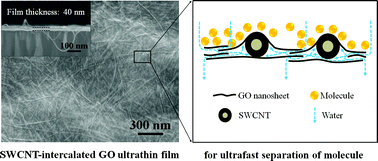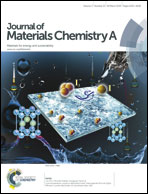SWCNT-intercalated GO ultrathin films for ultrafast separation of molecules†
Abstract
Laminar separation membranes fabricated with two-dimensional nanomaterials have been extensively explored to achieve the separation of molecules and water purification. Herein, single-walled carbon nanotube (SWCNT)-intercalated graphene oxide (GO) ultrathin laminar films are successfully prepared and used for the separation of molecules with sizes greater than 1.8 nm. Nanochannels created by the intercalation of SWCNT into GO layers greatly improve water permeation compared with pure GO films without sacrificing the rejection of nanometer-scale particles and molecules. A SWCNT-intercalated GO film with a thickness of 40 nm can effectively separate Bovine Serum Albumin, cytochrome c, Coomassie Brilliant Blue and Rhodamine B with fluxes of 660–720 L m−2 h−1 bar−1, which are about 10-fold higher than the fluxes of traditional nanofiltration membranes with similar rejection properties. The films also exhibit high separation efficiencies of 97.4% to 98.7%. Moreover, the SWCNT-intercalated GO films exhibit excellent pH-stabilities when used in extreme pH conditions, and it is superior to most of the ceramic- and polymer-based membranes. The SWCNT-intercalated GO films have a promising potential to be used as advanced separation membranes for water purification and chemical refinement.


 Please wait while we load your content...
Please wait while we load your content...